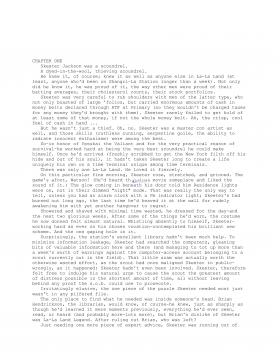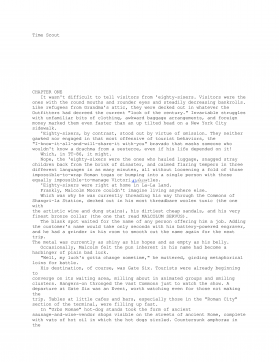Oberg, Jim - Space Power Theory - 06 - Text
VIP免费
2024-12-02
1
0
596.84KB
172 页
5.9玖币
侵权投诉
1
1
The Impact of Space
Activities Upon Ordinary
Citizens and the World
“Let us conquer space!” was the rallying cry of a faction in the US
Congress early in the 19th Century. Their strategy was to use federal
funds to build a paved road westwards from Maryland through the
Cumberland Gap, toward the open spaces of Ohio.
In proportion to modern federal budgets, the project was to be as
expensive as the Apollo program a century and a half later.
Opponents argued that it would be a “road to nowhere,” that at the
far end would be only “empty desolation and howling savages.”
There were a dozen more worthy and more immediately beneficial
projects for the expenditure of public money.
After long debate, the highway—called the “National Road”—was
built, and as with later cases of federal investments in new frontiers, it
paid off magnificently. Likewise, federal investments in and subsidies
of canals, railroads, advanced ocean-going technologies, aircraft, and
so forth have opened doors and lowered thresholds for public and
commercial traffic to flow through. Federal spending on military
forces has protected this flow of commerce as each opportunity and
technology came along, both from overt hostilities and from natural
dangers.
The arguments in today’s “conquest of space” have likewise
already been won. After decades of debate on what would be
worthwhile to do in space, government (both civil and military) and
commercial programs are in full swing, taking advantages of the
unique opportunities that space access offers. To the extent that these
2
The Impact of Space Activities Upon Ordinary Citizens and the World
applications have become invisible mainstays of modern life, most
Americans seem to remain unaware of how deeply space assets are
woven into the fabric of their daily lives.
But exploitation of space is a two-edged sword. Insofar as space
applications have often proved superior to old earthbound ways of
doing things, the better ways have come to dominate and push out the
former systems. In some areas, such as communications, astronomy,
or other scientific research, space remains a specialized supplement to
competing or complementary ground systems. In other areas—
weather forecasting, navigation, reconnaissance—space systems have
so outclassed former competitors that these functions soon (if they’re
not already) will be nearly impossible to perform without the space
systems, as ground-based systems atrophy and wither away.
Exploitation of space is thus also a dependence on space. More
specifically, it is a dependence on the security and dependability of
space-based assets against all threats, both man made and natural. As
these dependencies grow, so too do the vulnerabilities and—for
anyone wishing us ill—the temptations. The vulnerabilities can be
exploited along a full range of power, from publicity-seeking and
thrill-seeking spoofing, to blackmail or terrorist-motivated
interference, to national-policy-influencing damage, to intentional
crippling assaults coordinated with earthside actions.
Before examining more closely the specifics, we must review the
unique characteristics of “space” and their implications on space
operations. This is also important because of the time-honored human
practice of thinking by analogy, of speculating based on perceived
parallels. Because space is quite literally “unearthly,” such attempts to
extend earthside experience to space often are misleading, sometimes
spectacularly and dangerously so.
And while we’re at it, it’s also important to define certain terms
used freely about space, such as “space control,” “space power,” etc.
These common terms often seem to have different meanings and
reflect different assumptions from different users. This ambiguity may
hide true disagreements or may allow the appearance of a counterfeit
consensus. Certainly, poor definitions prevent the construction of
reliable theories on top of them.
Space Power Theory
3
“Understanding space” is still a challenge today not because
people know so little about space, but because they know so much
about space that isn’t accurate. “It ain’t what yuh dunno what’ll make
yuh look lak a fool,” goes the old Appalachian proverb, “It’s what yuh
DO know, what ain’t so.” And joking about “rocket scientists” rests on
the unspoken assumption that ordinary citizens won’t EVER be able
to understand space, which is a dangerous abdication of their
responsibility as citizens and as customers.
Whether it’s the still widespread notion that spacecraft float in
space because they are “beyond Earth’s gravity,” or the still-seen
misconception that rockets need something external to push against (as
in the notorious
New York Times
put-down of Robert Goddard), or the
more subtle misunderstanding that the reason objects heat up when
hitting the atmosphere is “air friction,”
1
most of us still are burdened
with inaccurate ideas about space. These misunderstandings—this
knowledge that isn’t so—lies in wait to ambush, deflect, and divert
people from adequate understanding of space and from the sound
decision making that such understanding enables.
“Space” is disconnected from most of the complexities of “earthly”
life, and so its parameters and principles can be listed—it’s a short
list—and understood relatively quickly. Here are some of the key
characteristics of “space” along with a few implications for operating
there.
Space really IS “unearthly.” It’s not LIKE our earthside
environment. There are some obvious differences, and some not so
obvious ones. The implication is that much ordinary “common sense”
doesn’t apply. One has to be cautious at making analogies with
“everyday life.” This implies that while it’s true that space is a physical
frontier, it’s also a mental one.
Space is BIG. Most of the Universe is “space.” Solid objects like
planets or other globs of matter (“the thick stuff”) are tiny dust motes
1 Objects heat up when hitting the atmosphere because the shock wave that forms
around the object compresses the atmosphere. When a gas is compressed, it gives off
heat. That heat is transferred to the object by conduction through the atmosphere,
raising the temperature of the object. That’s different from the heat that aircraft
experience, which is caused by friction in the laminar flow over the aircraft’s surfaces,
which is also conducted to the aircraft.
4
The Impact of Space Activities Upon Ordinary Citizens and the World
in a universe consisting mostly of space. This implies that once you
know how to operate in one area of space, you basically can operate
anywhere in the Universe that you can get to. Its very size imposes a
new form of isolation in terms of communications time delay. This
time delay is enough to be noticed and to irritate customers using
geosynchronous satellites for two-way telephone conversations.
Space is NEARBY. Just a hundred kilometers above us, the
physical conditions are those of “outer space.” Neglecting air drag, a
cannon shell fired vertically at 1,600 m/sec (about one mile per
second) will reach “space” in about three minutes. Space is as close as
your pager, your mobile telephone, your GPS navigator, and your
television remote, and it will soon be as close as your laptop computer.
Space used to be a barrier, but like the oceans, it is being transformed
into a medium for transportation and a medium for harvesting.
Since space extends “up” forever, so “high above” the rest of Earth,
objects in space have a VANTAGE POINT for viewing large areas on
the ground, or for being seen by two different areas on the ground so
as to relay signals. So it’s often the best place from which to view the
“big picture” of the Earth’s surface and atmosphere, or the “little
picture” of specific areas of high interest. Like an antenna on a
skyscraper or a mountain, it can serve as a location for
communications relay equipment. Furthermore, the global coverage
provided by space includes areas of the world that are denied to
earthside elements of US national power.
Space is mostly EMPTY of matter. There are random molecules,
atoms, and ions flying around, but no “air pressure”—it’s a “hard
vacuum.” This implies that there is no physical “speed limit” since
there’s nothing to slow down fast objects; also, there’s nothing to
“push against,” so wings and rudders and parachutes and things like
that don’t work. On the other hand, without crosswinds and currents,
future flight paths are simple to predict because there are few forces
acting on objects. Also, the emptiness means there’s nothing to absorb
radiation, either as protection or as veiling of our view of distant
objects.
Space is often FULL of energy flow. Usually, there’s uninterrupted
sunlight (except when in the shadow of a stray piece of matter).
Ultraviolet rays can give unprotected skin a sunburn in seconds, and
Space Power Theory
5
cause severe eye damage in minutes through a too-transparent
window. In fact, as Ted Johnson of Boeing puts it, those of us in space
are bathed in energy. There is more than enough energy to sustain
billions of lives, if we could learn how to efficiently harness it. BUT
paradoxically, space can also be very cold since it’s an infinite heat
sink. The temperature of an inert spacecraft at Earth’s distance from
the sun will stabilize passively slightly below the freezing point of
water. The temperature of the unlit floors of craters at the Moon’s
north and south poles have cooled far lower and created “cold traps.”
These “cold traps” catch and accumulate passing water molecules to
form the ice layers recently confirmed by space probes (the same logic,
and some intriguing radar data, suggests that sun-scorched Mercury
also has ice in its polar craters).
Space has physical effects on people who travel there and the
hardware that we send there (since it’s different from conditions we
evolved under). It will quickly kill an unprotected human being and
may disable unprotected equipment. The concern for space engineers
is how MUCH of Earth’s natural environment you need to carry with
you to keep you and/or your equipment functional.
Next, after looking at the characteristics of the space environment,
what are the characteristics of SPACE FLIGHT?
Spaceflight is NEW. After millennia of dreaming, there’s been no
more than half a century of human physical access to “space.” This
means it’s still often SURPRISING, both in scientific terms and in
unpleasant discoveries of new ways to “crash and burn”—and we
should expect it to keep surprising us for a long time to come. And
since it’s so strange, most earthside analogies are strained at best, and
are misleading at worst. Spaceflight is only a few decades younger
than powered flight within the atmosphere. This chronological
relationship has led to some of the strained or misleading analogies.
Spaceflight is EXPENSIVE and HARD. As a result, new
technologies are required which often have later, wider applications in
earthside industries. This implies that no known raw material is costly
enough to be profitably exported to Earth from space. However,
INFORMATION is precious and massless, and there’s where the
profits are—space often provides information-transfer services much
more cheaply than corresponding earthbound alternatives. In the
摘要:
展开>>
收起<<
11TheImpactofSpaceActivitiesUponOrdinaryCitizensandtheWorldÒLetusconquerspace!ÓwastherallyingcryofafactionintheUSCongressearlyinthe19thCentury.TheirstrategywastousefederalfundstobuildapavedroadwestwardsfromMarylandthroughtheCumberlandGap,towardtheopenspacesofOhio.Inproportiontomodernfederalbudgets,t...
声明:本站为文档C2C交易模式,即用户上传的文档直接被用户下载,本站只是中间服务平台,本站所有文档下载所得的收益归上传人(含作者)所有。玖贝云文库仅提供信息存储空间,仅对用户上传内容的表现方式做保护处理,对上载内容本身不做任何修改或编辑。若文档所含内容侵犯了您的版权或隐私,请立即通知玖贝云文库,我们立即给予删除!
分类:外语学习
价格:5.9玖币
属性:172 页
大小:596.84KB
格式:PDF
时间:2024-12-02



















 渝公网安备50010702506394
渝公网安备50010702506394
